Many Anthurium hoarders are fond of the Anthurium Black Beauty. And that would be because it is one-of-a-kind, and there are not that many of them around.
The exceptionally long-lasting Anthurium Black Beauty is a fashionable, elegant, and flirtatious plant that complements any home interior.
They are sturdy and reliable, ensuring abundant and long-lasting flowers year-round. Absolutely gorgeous plant with plenty of blossoms!
To ensure that Anthurium Black Beauty thrives in your condo, you must first become acquainted with the species and the growing environments.
The Anthurium Black Beauty necessitates little maintenance, and here are all its ABCs.
Table of Contents Show
Anthurium Black Beauty Overview
Anthurium Black Beauty is native to tropical South American regions and is a member of the arum family (Araceae).
It is a member of the Anthurium plant family, which has over 600 representatives. It stands to reason that it can prosper in indoor settings because it is a tropical species.
Anthurium Black Beauty is named after the Greek words “anthos” and “oura,” which imply “tail flower.”
It is also known as ‘Flamingo Flowers,’ which are prominent as flowers in bouquets due to their striking heart shape and three-week vase life.
| Common name | Anthurium Black Beauty |
| Origin | Colombia to Ecuador |
| Family | Anthurium |
| Genus | Anthurium Schott |
| USDA Zones | Hardiness Zones 10 to 12 |
| Plant Type | Epiphytic |
| Growth Habit | Can reach up to 65 cm |
| Foliage | Glossy Foliage that changes color as it matures |
| Flower | Tulip-like small flowers; Blooming Season: Spring |
| Toxicity | Toxic to both humans and animals |
Anthurium Black Beauty Care Guide
The spathes bursts from the bottom of the bulbous spike where the precise tiny blossoms sprout, the red, white, pink, or purple waxy foliage.
And that is what renders these hardy, low-maintenance houseplants so alluring. Below is a summarized version of the care tips for your convenience!
| Requirements | Optimum Conditions |
|---|---|
| Light requirement | All thresholds of indirect lighting |
| Water requirement | Medium Watering; Water if the top half of soil is dry |
| Temperature | 70°F (20°C) and 77°F (25°C) |
| Humidity | 80% and above |
| Growing medium | Well-draining standard potting mix or orchid mix |
| Fertilizer | Feed a high in phosporus; Feed once every two months in spring and summer |
| Re-pot frequency | Once in two years, depending upon the plant and pot size |
| Propagation methods | Root division and seed germination |
| Pest | Spider mites and Aphids |
| Disease | Fungal disease; Bacterial Leaf Spot; Bacterial Wilt |
1. Sunlight and Location
Take into account that in its native environment, the Anthurium Black Beauty evolves in the canopy of treetops.
Even when risen in the open air, it is innately shielded from harsh and direct sunlight.
Anthurium Black Beauty can thrive in all thresholds of indirect lighting. Luminous, indirect light is the optimal growth setting.
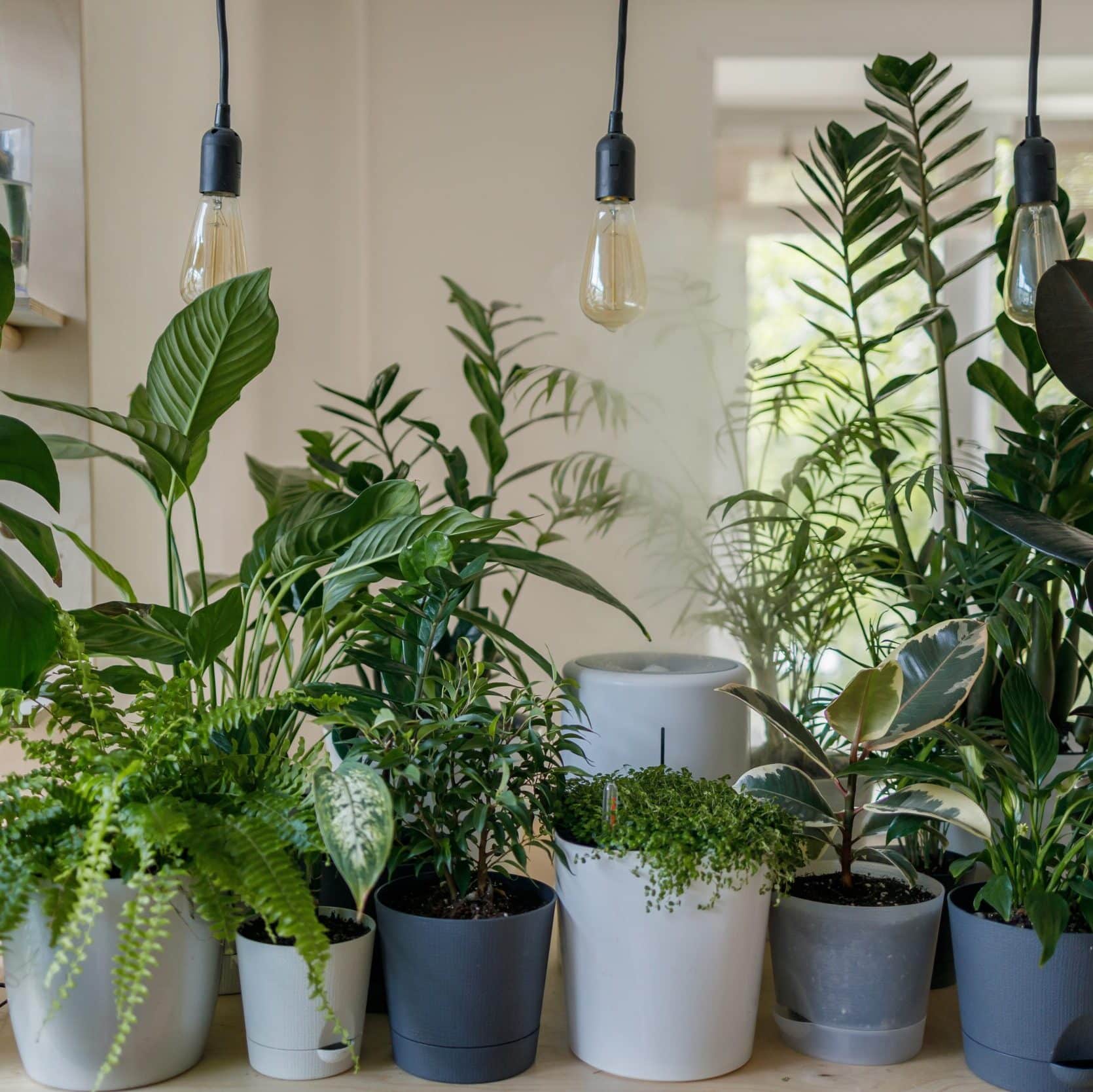
Even in a darker environment, you can maintain an Anthurium Black Beauty as a potted plant.
However, please remember that it will develop more slowly and produce fewer blossoms than those reared in vibrant, indirect natural light.
The only place you wouldn’t want to hold these beauties is in direct sunlight.
If you don’t have a place in your residence where an Anthurium Black Beauty can get enough light, you can employ a grow light alternatively.
Grow Lights are as decent as natural sunlight (if not better, thanks to the intensity controls).
Always remember that Anthurium Black Beauty does best in indoor locations or if you wish to place it outdoors, possibly in a shady location.
If you plan to keep it by a window, make sure that the light is filtered and not extremely harsh.
Signs and Symptoms of Improper Lightning
Your Anthurium Black Beauty is receiving too little light if:
- Your plant has a leggy appearance,
- The plant has very tiny leaves,
- The development has stopped or slowed,
- Your plant appears stunted and takes very long to give new leaves.
Your Anthurium Black Beauty is receiving too much light if:
- The leaves appear crumbled, scorched, and dry,
- Browning and burnt leaves.
- The soil is always dry, even within a few hours after a watering schedule,
- The plant looks limp and unhealthy.
2. Moderate Watering
Hydrate Anthurium Black Beauty when the growing medium’s top 2-3 inches looks dry. Apply pressure on the soil to decide.
There must be no hydration present before the watering routine.
Rather than watering on a regular basis, only water Anthurium Black Beauty when the soil is partially dry.

Keep in mind that the roots must be well-hydrated but not wet or mushy. Make sure to reduce the watering schedule as soon as the winter begins.
In fact, many plant lovers report that they water their Anthurium Black Beauty once in 2 weeks only during the cold seasons.
You can use ordinary tap water for your beauties. However, make sure that your tap water is not heavily chlorinated.
Pro Tip: Fill a pitcher with water and let it sit overnight to remove excess chlorine from the water.
Black Beauty Anthurium Plants are drought-resistant, so you don’t have to worry about them drying out.
Anthurium Black Beauty can be watered in various ways because it is not fussy. Go with the method that fits best:
To-down watering
Sprinkle water over the growing medium with a watering bucket or place the plant explicitly under a faucet. Keep filling the pot until the water begins to seep out of the drainage holes.
It is better to use a plate under the planter, but make sure to wipe all of the collected water. Never let your Black Beauty settle in water.
Bottom-up watering
Replenish the plant plate halfway with water. Pause for about 10 minutes after making sure the soil is in contact with moisture in the plate.
Touch the soil to see whether it has soaked up sufficient water, and eliminate any extra moisture from the plate if the soil is wet enough.
Alternatively, add more water to the plate if it is still dehydrated. Repeat the process for another 20 minutes before removing the plant from the tray.
Signs of Overwatering
- Overwatering causes crippled, slow development with yellow foliage.
- Water-soaked patches and papules (Oedema) may appear on the stem and foliage.
- The plant’s crown may also gather moisture and rot.
- Your plant may look limp, and new growths will develop brown patches.
Signs of Underwatering
- Plants that are underwatered grow sluggishly and have brown, dried leaves corners.
- The plant may lose leaves or blossoms or not bloom at all.
- Lower leaves are usually the first to undergo, becoming yellowed and crinkled.
- Your plant ultimately dries up and perishes.
3. Warm Temperature
Because Anthurium Black Beauty is a species native to tropical weather patterns, it thrives in warm temperatures, explicitly between 70-77°F (20-25°C) if kept inside.
It can withstand the warmer weather, but you must be careful during the cold since the plant’s ideal region lies in USDA 10-12.
You can say that Anthurium Black Beauty prefers having consistent weather, i.e., warm and sunny.
It is acceptable to leave the plant outdoors during the summertime but bring it indoors when the nighttime temperature decreases below 50°F (10°C).
If you believe your plant requires additional warmth, you can even use heating pads to keep it warm and nippy!
Tips: Alternatively, you can use a frost blanket to protect the plant from cold stress.
4. High Humidity
The Anthurium Black Beauty is indigenous to wet and warm tropical regions like Colombia and Ecuador. In its native surroundings, it is thought to be a longstanding plant.
Considering the Anthurium Black Beauty’s native origins, it is no wonder that it prefers humid indoor spaces when kept as a potted plant.
It is essential to maintain the humidity at about 80%.
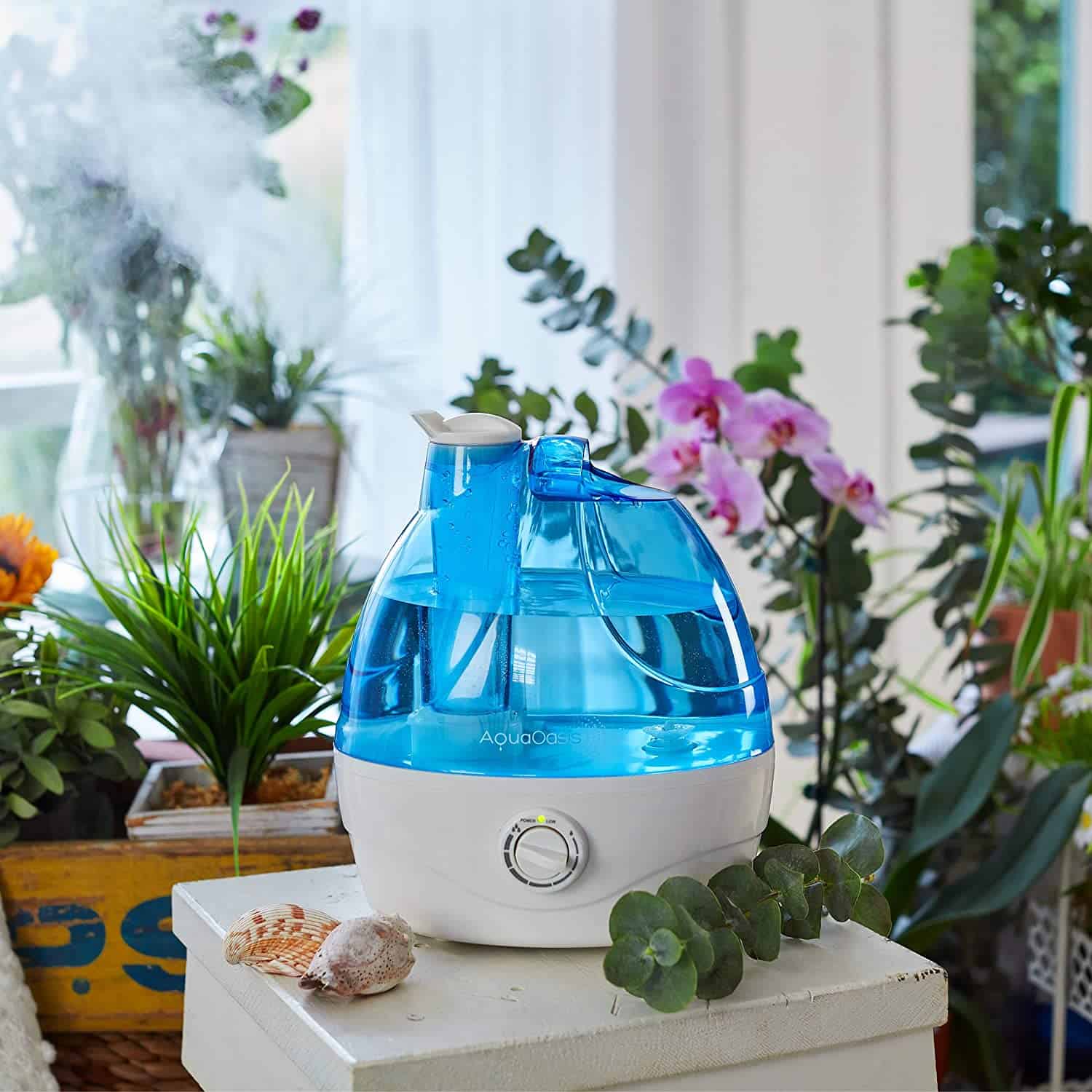
This is the threshold at which the Anthurium Black Beauty will prosper.
However, in lack of the suitable humidity, your Purple Black Beauty might suffer from:
- Brown tips on Leaves
- Loss of water (from the plant’s body and soil mix)
- Curled and wilted Foliage
If the leaves on the Anthurium Black Beauty leaves begin to lose their luster and turn dreary green, it is most likely due to a lack of humidity.
Please remember that they develop organically in the jungle and prefer a very moist environment.
Spritz your plant with water at room temperature every so often to add some moisture to the air. Avoid putting the plant near a vent or heaters that produce hot and dry air.
It is critical to establish a constant humidity level because radical changes can be detrimental to the plant.
Buy a decent humidifier or use a humidity tub to show your beauties some extra encouragement!
5. Well-Draining Soil
Black Beauty Anthurium Black Beauty favors slightly acidic soil with a pH of 5.5 to 6.5.
You will want well-draining soil and a planter with a few drainage holes to build the perfect soil environment for Anthurium Black Beauty.

A potting mix originally tailored for orchids, with some supplemental sand and peat moss, would be excellent.
Anthurium Black Beauty requires soil that drains well while holding some water to keep the plant hydrated.
If you can’t do the orchid mix with sand and peat moss, try a mixture of regular potting soil and orchid mix in a ratio of 1:1. This hack will also work similarly.
DIY Soil Mix recipe for your Anthurium Black Beauty to thrive:
- 50% Miracle Grow Moisture Control Potting Mix
- 20% Peat Moss
- 20% Orchid Potting Mix
- 10% Perlite
Here are some great potting mixes for your Anthurium Black Beauty:
- Organic Potting Mix by Perfect Plants for All Plant Types
- Espoma Organic Potting Soil Mix
- Miracle-Gro Orchid Plant Food Spikes and Orchid Potting Mix – Coarse Blend
6. Water Soluble Fertilizers
Anthurium Black Beauty requires fertilization every two months or so to remain alive and comfortable.
In the spring and summer, nourish your Anthurium Black Beauty plants with a water-soluble fertilizer diluted to 1/4 strength every two months.

They cannot tolerate high doses of plant food and will burn.
Tips to Fertilize Black Beauty Properly
- Also, never fertilize a distressed plant with brown leaves.
- Fertilizers must have high middle-range phosphorus (helps plants to flourish) levels.
- Fertilize less in the dormant phase, i.e., autumn and winter, since the growth is innately decelerated.
- You can also prepare your own compost fusion at home from vegetable scraps and fruit peels to naturally replenish your plants.
Natural plant food includes eggshells, tea bags, and coffee grounds.
- To pull the salt that has stockpiled in the soil, you could perhaps cleanse it out every few months.
Cleansing Process-
Simply place the potted plant in the washbasin and thoroughly rinse over the soil letting the water out of the drain holes for about a minute.
This will eliminate any salt that has accumulated in the growing medium. Avoid fertilizing the plant if the growing medium (soil mix) is parched.
Here are some great plant nutrients for your Anthurium Black Beauty:
- Miracle-Gro LiquaFeed
- EarthPods Premium Concentrated Cal-Mag Plus Plant Food Spikes
- TeaDrops Organic Seedling + New Planting + Transplant Fertilizer
7. Potting and Repotting
It is always recommended to re-pot your Anthurium Black Beauty when the plant is root-bound. These plants grow in relation to the care and location they are given.
Ideally, you could re-pot them once in two years if placed indoors.
Make sure that you re-pot your Anthurium Black Beauty only during the spring or early summer.
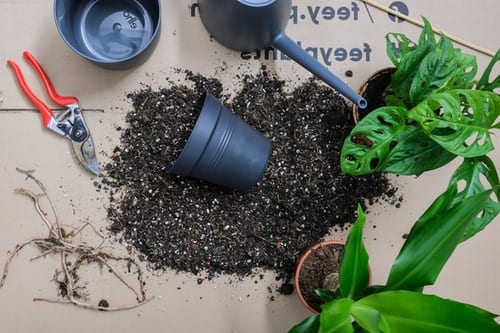
It would be great if you used a terracotta or ceramic pot with plenty of drainage holes for airflow.
When selecting a new one, consider using a planter that is only fractionally larger than the previous one. A good guideline is to go 1-2″ larger.
If you choose a pot that is too big, the new soil may not be able to dry out easily enough between waterings, causing your plant to smother in the moist soil.
Signs your Anthurium Black Beauty needs Re-potting
- It is shaky, dull, and has stopped producing new growths,
- Roots have started emerging out of the drainage holes,
- It is top-heavy and easily droops,
- Water runs straight through the pot when watering without making the soil wet.
Steps to Re-pot Anthurium Black Beauty
i) Remove the Plant from the Old Pot
Delicately grasp the plant and begin to dislodge the pot, being careful not to pull on the stem or strands.
Try cutting the soil bare from the pot’s corners with a sharp knife if it is difficult to remove. You can also press the exterior of the pot lightly with a spear.
ii) Prune the Unruly Roots
Perform a root oversight and eliminate anything that appears dead, stinky, or decayed.
If the soil and roots appear to be in good condition, avoid stressing the roots since it may cause additional pressure on the plant.
Thick, braided roots should be carefully unscrewed with your fingers or simply snipped away.
Peeling away about 20% of the roots may help to keep the plant youthful and compact enough to live in the same planter for the foreseeable future.
iii) Pour Soil into the Pot
Fill the bottom of the planter with soil. Remember to put enough – the root ball should be a few inches under the periphery of the pot.
If the soil isn’t placed appropriately, your pot will bubble up when watered.
iv) Final Step
Before you continue to add more growing medium, position the plant on the soil and make sure it is centered.
Add soil around the plant, softly tapping it with your fingers to firm it up and ensuring that your plant is not buried any deeper than it was previously.
After hydrating the plant, you may need to incorporate more soil. Before you finish, make sure your plant has just enough soil around its root system.
Plants are stressed when they are re-potted. And, it tends to take about a month for your plant to make a full recovery and begin enjoying the newer and better surroundings.
Here’s how to take care of your Anthurium Black Beauty after a good re-pot:
- Put the plant in a pleasant but shaded location.
- Water it, but try to stick to the schedule as much as possible (only for re-potted plants).
- Don’t give it any supplements. The new soil is already rich in plant food, so introducing more could harm the already agitated roots.
9. Regular Pruning
Black Beauty Anthurium pruning is only necessary to eliminate spent blossoms and compromised and/or dying leaves.
Only use hygienic pruning toolkits to avoid infection spread when trimming the plant. Be sure to wipe your toolkits with alcohol to sanitize them.
It would help if you pruned any overgrown stems or foliage. This maintains the plant’s appearance as tight and sleek as possible.
The removal of any dead, old, yellow, brown, or defected foliage is another aspect of pruning. Aside from that, there isn’t much to do in terms of grooming and upkeep.
There is no particular season (Spring is the best season) when it comes to pruning Anthurium Black Beauty; prune it when you see a dead leaf or flower!
It is not best to remove all the leaves while pruning Black Beauty for the first time.
Pro Tip: Pruning off the main stem is a big NO NO.
Anthurium Black Beauty- Feature and Growth Rates
Anthurium Black Beauty is an epiphyte found in the tropics.
With appropriate maintenance, Black Beauty Anthurium (slow-moderate grower) can reach a height of 65 cm.
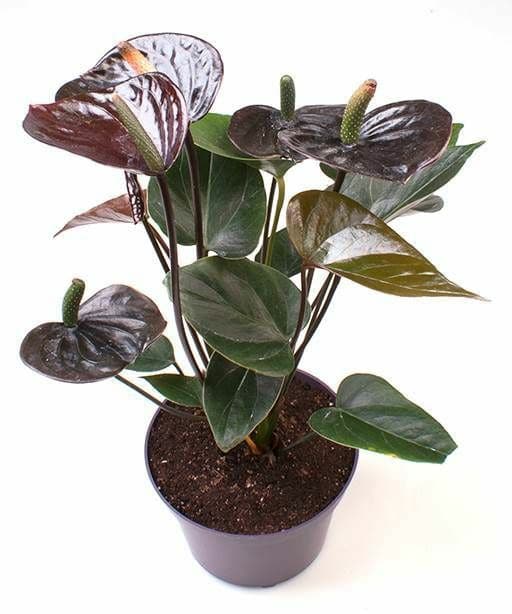
The plant flowers in the spring and fall, but its distinct appearance and foliage colors are what makes it so appealing.
Its foliage is a vibrant green color. They have burgundy specks running along with them. However, the colors of the leaves will change as it gets older.
The buds are black and burgundy at the start of sprouting and slowly improve to black. In any scenario, the leaves and black blooms are its main draws.
The blossoms of this Anthurium Black Beauty species are shaped like tulips.
If your Anthurium Black Beauty isn’t flowering, it could be because it isn’t getting the right combination of humidity, light, and water.
Not getting vitamins from its potting medium can be the other reason. To begin troubleshooting, make sure you are following the instructions mentioned above.
Also, make sure you use a phosphorus-rich fertilizer.
If you want your flower to last longer, increase humidity around your Anthurium Black Beauty plants.
Spritzing water or placing them near a humidifier can be beneficial. Make sure they get ample bright indirect sunlight and water, just enough to keep the soil moist but not wet.
If properly maintained, you can keep your Anthurium Black Beauty alive and happy for several years.
Propagation Methods for Anthurium Black Beauty
Anthurium Black Beauty replicates itself through several methods such as Stem cutting, Root Division, and Seed germination.
Root division is the most straightforward and fastest way to propagate Anthurium Black Beauty. It also ensures that your plant flowers as soon as possible.
On the other hand, the seed germination method is a longer process, and your plant may take more than two years to grow.
1. By Root Division
Dividing the roots is the simplest way to multiply the plant. Because the plant’s root system continuously expands, you can do this every few years.

To reproduce in this manner, the root system must be removed from the soil and divided into sections, which are then planted in separate containers.
Hers’s how you can effortlessly divide your plant:
- Plants should be divided in a clean environment with sterile tools and hands.
- Select plants that are healthy and strenuous for propagation.
- Extract the plant from its container and discard any excess soil from the roots.
- Delicately split the plants, separating each with a distinct stem, leaf, or crown.
- Plant each segment as a separate plant in a suitable-sized pot filled with good potting soil.
2. By Seed Germination
If you are an impatient plant enthusiast, seed germination may not be the best propagation method. Well, in any case, here are the steps involved in the process:
- It is recommended to soak the seeds for about 8 hours prior to germination to speed up the process
- Prepare a propagation tray with sterile cocopeat.
- Lay about one-third of the tray with a layer of growing medium (cocopeat) and insert about three seeds in each compartment of the tray.
- Cover the seeds with a light layer of soil.
- Place the tray in a shaded location (indoors).
- Water the arrangement on a daily basis.
- Keep the tray covered with a thin layer of plastic (with few holes) to retain moisture.

- After about 8-10 days, you will see a few Anthurium Black Beauty Sprouts. Once the plant has developed about 3-4 leaves, you can remove the plastic.
After 30-45 days, you may plant your Black Beauty in a new potting container.
For full detail on Anthurium propagation here is How To Propagate Anthurium? Hurry up and replicate the beauty!
Is Anthurium Black Beauty Toxic?
Black Beauty Anthurium, if consumed, is highly toxic, so exercise extreme caution if you have animals or younger kids.
Calcium oxalate crystals in the plant body cause an adverse reaction.
If you chew on the plant parts, you will feel a painful burning sensation in your throat. Blisters and swelling inside your mouth are possible as well.
If you notice that your furry buddies or kids have ingested the plant, watch out for symptoms. If the victim starts drooling or showing signs of allergy, take them to a nearby hospital immediately.
Hurry!! Contact the ASPCA at (888) 426-4435 or your local veterinarian right once.
Common Problems in Anthurium Black Beauty
Here are some common issues plant lovers often come across with the Anthurium Black Beauty and solutions for fixing them.
1. Common Pest
Spider Mites and Aphids can be regarded as major troublers in the case of your Black Beauty.
Aphids, such as spider mites, are sap-sucking insects that can invade Anthurium Black Beauty cultivated in damp environments.
Spider mites, on a brighter note, are easy to spot.
If you notice small white insects assembling around the plant when you tenderly stir it, you have a spider mite problem that needs to be addressed.
They are ubiquitous in Anthurium Black Beauty plants grown indoors in overly wet conditions.
Solutions
- Treat Black Beauty with insecticides.
- Bombard the plant with soap water or insecticidal soap, including the undersides of the foliage, and then reapply as directed.
- Wipe the insects from the plant using a cotton ball dipped in isopropyl alcohol. Use the solution after diluting with an equal amount of water.
- Handpicking is also an excellent way to get rid of the pest if they are smaller in number.
- Spray the pests with a forceful stream of water to get rid of them. To prevent plants from being overwatered, cover the soil with plastic.
- In the case of a severe infestation, pyrethrin spray can help control the bugs.
- You can also use organic pesticides like neem oil and horticulture oil for pests infection.
Preventive Measures
- Immediately isolate the plant with even a slight doubt of infestation.
- Take care of the issue by reducing watering frequency since damp conditions favor these pests.
- Inspect the plant thoroughly before bringing it to your collection.
- Plants with high nitrogen levels and slow development attract pests, so don’t overwater or fertilize.
- Allow enough space around the plant for air to flow freely.
- Once a month, give your plant a good wash with clean water to eliminate any pests.
- Remove weeds and grass from around plant areas.
- Similarly, you can control pests with yellow sticky traps.
- You can also use organic pesticides like neem oil and horticulture oil as they interfere negatively in the pests; breeding process.
2. Bacterial and Fungal Disease
Powdery Mildew
Causative agent: Podosphaera xanthii
Powdery mildew commonly impacts Anthurium Black Beauty and is caused by many specialized races of fungal species in the genera Erysiphe, Microsphaera, Phyllactinia, Podosphaera, Sphaerotheca, and Uncinula.
At first, it causes circular chalky white spots on plant leaves. The fluffy white fungus can infect the whole plant material as the infection progresses.
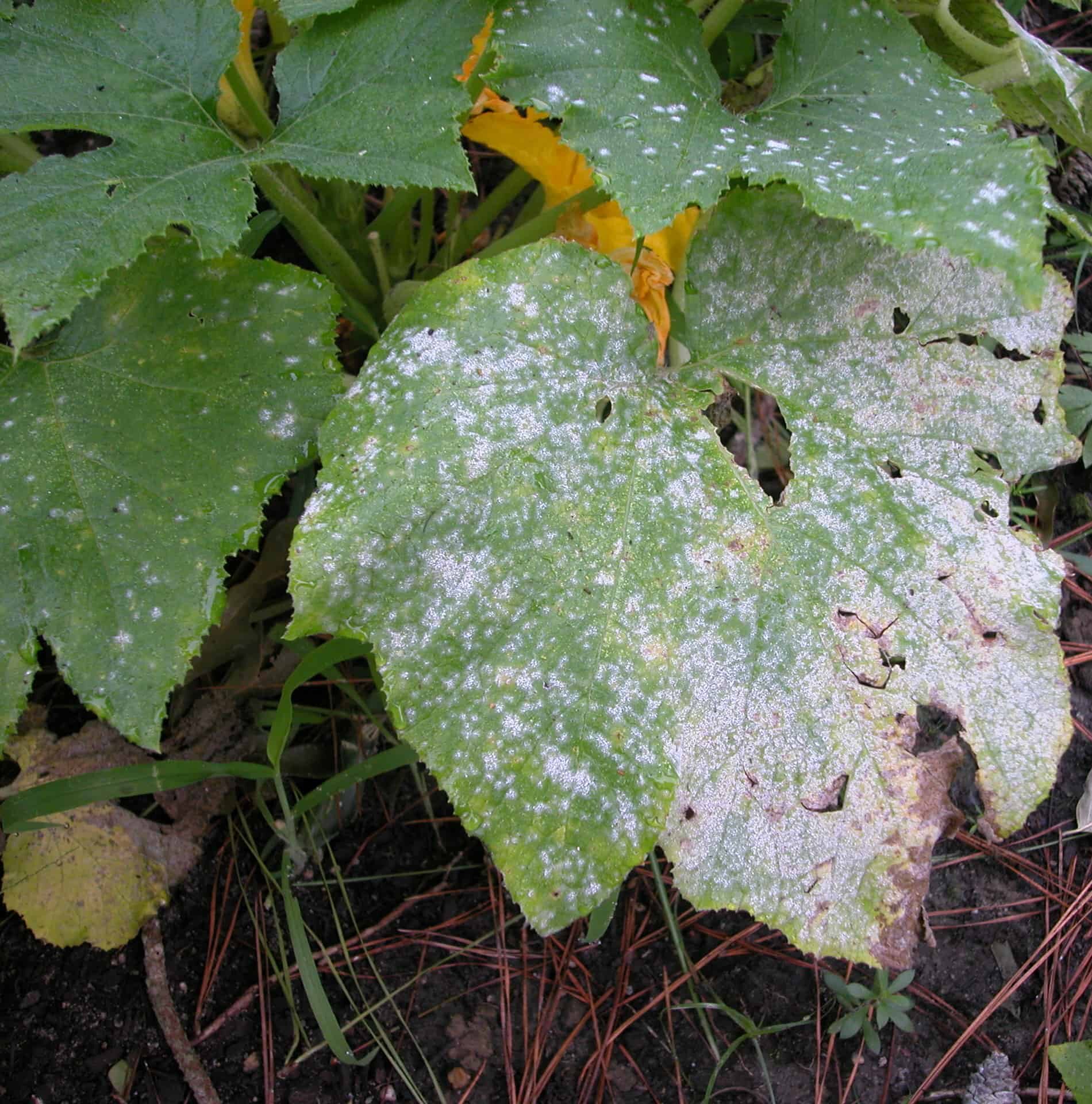
Powdery mildew is a disease that is responsible for making the leaves curl.
Brown patches on foliage or flowers usually confirm the existence of fungus. Plants afflicted with fungus may not be saved, but there is a likelihood if caught early.
Using sterile shears, snip off any contaminated growth.
DIY Solution
- One gallon of water,
- One-half teaspoon of liquid soap and
- One tablespoon of baking soda
Spray the solution on the plant or use organic fungicides that contain sulfur to get rid of this disease.
Bacterial Blight
Causative agent: Xanthomonas axonopodis pv. dieffenbachiae
Bacterial blight is a significant issue for Anthurium Black Beauty.
If the foliage starts to establish yellow water-soaked tumors that turn brownish-black before dropping dead, this is a symbol of blight.
The blight is especially severe in areas with high humidity and high late evening temperatures.
Solutions against Bacterial Blight
- It is critical that you use disinfected pruning tools to remove the damaged leaves from the plant.
- Reduce the humidity and indoor temperature to avoid future flare-ups of blight.
- Apply Agrimycin to treat infections.
Bacterial Wilt
Causative agent: Ralstonia solancearum
Suppose you examine the plant’s foliage and notice that the leaf veins of the Anthurium Black Beauty are yellowish.
If the leaf starts turning brownish-bronze, and the plant wilts despite receiving adequate water, you are most likely interacting with bacterial wilt.
Solutions against Bacterial Wilt
- The best way to combat bacterial wilt is to use only sterile and clean soil, sterilized tools, and spotless containers.
- Maintain a clean environment around the plant by removing debris and dead leaves.
Preventive Measures
- Avoid overcrowding your plants.
- Maintain a proper watering and fertilizing schedule and prevent your plant from stressing out (stressed-out plant is highly susceptible to disease).
- Provide the plant with enough sunlight and air circulation to maintain good health.
- Over mulching is a classic case of disease infestation that should be avoided.
- Always create a well-balanced soil with good texture, aeration, and nutrition content.
- Sanitize everything before bringing it closer to the plants.
3. Leaves Turning Yellow
If your plant’s foliage is turning yellow or fading, it is either too watery or too cold.
Yellowing foliage indicates a number of other probable problems in our care. Don’t worry; your foliage can retain its original color with timely remedies.

Here is a table of those stress with some easy-to-do solutions.
| Stress | Solutions |
|---|---|
| Moisture Stress | Change the pot from compact plastic to clay or terracotta with plenty of drainage holes. |
| Light Stress | Keep away from light-exposed windows or patios. Use grow lights in fall and winter. |
| Lack of Nitrogen | Apply plant food every 8-weeks. Use fertilizer rich in Nitrogen |
| Humidity Stress | Add a room air humidifier or mini-greenhouse at home |
| Diseases | Avoid overly moist locations at home. Avoid foliar spraying the plant. Use certified and sterilized potting mix. |
4. Brown Leaf Tips
If the edges of your plant’s foliage are turning brown, it is most likely due to overexposure to sunlight or a lack of humidity in the air.
It is preventable and is not much of an issue if you responsibly dedicate your time to your Green Pal.
Solution and Preventive Measures
- Water your Anthurium Black Beauty properly and timely.
- A well-draining soil mix may prevent the browning of the foliage tip.
- Make sure it is never in direct sunlight and relocate it away from the window.
- Spritz with water or place near a humidifier to increase humidity.
FAQs on Anthurium Black Beauty
Are Anthurium Black Beauty and Black Queen the SAME?
These two plants are different though they have maximum common resemblances—both bloom with a deep purple flower.
Both of them have very dark leaves, black in color, but they’re not the Same.
Well there are many more different varieties of Anthurium, an article on Anthurium Varieties might interest you.
Where can I Buy Anthurium Black Beauty?
You can go to your nearest nursery but let me warn you there is a higher chance that those stores or nurseries might run out of stock.
I find it easier to order online and get delivery at my doorsteps. Some of the online stores providing this service for Anthurium Black Beauty are:
| Places to Buy | Delivery Service | Rate |
|---|---|---|
| Etsy | Your product will likely arrive within 7-10 days | 139.96$ |
| Orchid Box | Within 2-3 days | 250$ |
| Nursery Buy | 4-7 days, Generally within 4 days | 549$ |
The rate in this table might vary according to the season and availability of the Plant.
Conclusion
Anthurium Black Beauty will amaze you with flowers almost all year with just a little care. As a result, offer it the attention that it deserves.
By implementing these strategies, you will be capable of keeping your Anthurium Black Beauty healthy and thriving in the best way possible.
We hope you will have a pleasant experience all around, from growing to nurturing your Anthurium Black Beauty.
For more such care guides, stay connected to Plants Craze!
For your convenience, our Care guide includes where to buy links! Try Anthurium Splendidum, Anthurium Cobra, Anthurium Plowmanii, Anthurium Ace of Spades etc.


